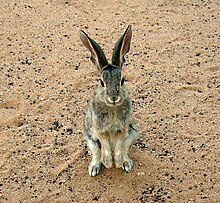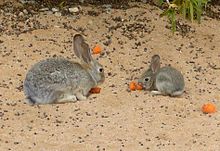| Desert cottontail | |
|---|---|

| |
| Conservation status | |
 Least Concern (IUCN 3.1) | |
| Scientific classification | |
| Domain: | Eukaryota |
| Kingdom: | Animalia |
| Phylum: | Chordata |
| Class: | Mammalia |
| Order: | Lagomorpha |
| Family: | Leporidae |
| Genus: | Sylvilagus |
| Species: | S. audubonii |
| Binomial name | |
| Sylvilagus audubonii (Baird, 1858) | |

| |
| Desert cottontail range | |
The desert cottontail (Sylvilagus audubonii), also known as Audubon's cottontail, is a New World cottontail rabbit, and a member of the family Leporidae. Unlike the European rabbit (Oryctolagus cuniculus), they do not form social burrow systems, but compared with some other leporids, they are extremely tolerant of other individuals in their vicinity.
Cottontails give birth to their kits in burrows vacated by other mammals. They sometimes cool off, or take refuge in scratched out shallow created depressions of their own making, using their front paws like a back hoe. They are not usually active in the middle of the day, but can be observed foraging in the early morning, and early evening. Cottontails are rarely found out of their burrows looking for food on windy days, because the wind interferes with their ability to hear approaching predators, their primary defense mechanism.
Lifespan


The lifespan of a cottontail that reaches adulthood averages less than two years, depending on the location. Unfortunately for the cottontail, almost every local carnivore larger or faster than the lagomorph is its predator. Some predators, like snakes for example, are familiar with the area inhabited by the cottontails, and can catch and eat the young at will; the mother is unable to defend the litter. Although cottontails are highly active sexually, and mated pairs have multiple litters throughout the year, few young survive to adulthood. Those that survive grow quickly and are full grown at three months.
Description
The desert cottontail is quite similar in appearance to the European rabbit, though its ears are larger and are more often carried erect. It is social among its peers, often gathering in small groups to feed. Like all cottontail rabbits, the desert cottontail has a greyish-brown, rounded tail with a broad white edge and white underside, which is visible as it runs away. It also has white fur on the belly.
Adults are 36 to 42 cm (14 to 17 in) long and weigh anywhere from 700 to 1,200 g (1.5 to 2.6 lb). The tail is 3.0 to 6.0 cm (1.2 to 2.4 in), ears are 6 to 9 cm (2.4 to 3.5 in) long and the hindfeet are large, about 7 to 9 cm (2.8 to 3.5 in) in length. There is little sexual dimorphism, but females tend to be larger than the males, but have much smaller home ranges, about 4,000 m (1 acre) compared with about 61,000 m (15 acres) for a male.
Distribution and habitat
The desert cottontail is found throughout the Western United States from eastern Montana to western Texas, and in Northern and Central Mexico. Its eastern range extends barely into the Great Plains. Westward, its range extends to central Nevada, central and southern California and Baja California, touching the Pacific Ocean. It is found at heights of up to 1,830 m (6,000 ft). It is particularly associated with the dry near-desert grasslands of the American southwest, though it is also found in less arid habitats such as pinyon-juniper forest. It is also frequently found in the riparian zones in arid regions.
Behavior
Diet and feeding
Cottontails are herbivores, with 90% of their diet consisting of grass. They also feed on the leaves and peas of mesquite, barks, fallen fruit, the juicy pads of prickly pear and twigs of shrubs. It rarely needs to drink, getting its water mostly from the plants it eats or from dew. Due to seasonality and changes in moisture conditions of their habitat, cottontails adjust their diets based on many influential factors that impact the seasonal changes of vegetation (i.e. moisture content, abundance, nutrition value, etc.). Like most lagomorphs, it is coprophagic, re-ingesting and chewing its own feces to extract the nutrients as effectively as possible.
The desert cottontail, like all cottontails, eats on all fours. It can only use its nose to move and adjust the position of the food that it places directly in front of its front paws on the ground. The cottontail turns the food with its nose to find the cleanest part of the vegetation (free of sand and inedible parts) to begin its meal. The only time a cottontail uses its front paws to enable eating is when vegetation is above its head on a living plant. The cottontail then lifts a paw to bend the branch and bring the food within reach.
Thermoregulation
Due to variable temperatures of their habitats, desert cottontails must be adequate thermoregulators to minimize water loss during the hotter seasons and require shaded areas of their environment to conduct evaporative water loss through thermal heat transfer. In open-desert areas, they can withstand for a short period extremely high temperatures of around 45 °C (113 °F), and have a large evaporative water loss capacity of around 1.5% body mass/hour, though cottontails can withstand longer in an ideal environment with shaded areas. To cope with evaporative heat loss, they do panting and undergo changes in production of their basal metabolic rate in relation to the ambient temperature of the environment. Ears of desert cottontails make up 14% of their body size and may help with thermoregulation.
Predators and threats

Many desert animals prey on cottontails, including birds of prey, mustelids, coyotes, bobcats, Mexican wolves, mountain lions, snakes, weasels, humans, and even squirrels, should a cottontail be injured or docile from illness. Alien species, such as cats and dogs, are also known predators, and also pose a threat. Southwestern Native Americans hunted them for meat but also used their fur and hides. It is also considered a game species, due to which it is hunted for sport. The desert cottontail's normal behavior upon spotting a potential predator is to freeze in place in an attempt to avoid being detected. If it determines that it is in danger, it will flee the area by hopping away in a zigzag pattern. Cottontails can reach speeds of over 30 km/h (19 mph). When defending itself against small predators or other desert cottontails, it will nudge with its nose, or slap with its front paws, usually preceded by a hop straight upwards as high as two feet when threatened or taken by surprise.

Habitat loss due to land clearing and cattle grazing may severely affect the population of the desert cottontail. Human-induced fires are also a potential threat for desert cottontail populations. Another factor is its competition with the black-tailed jackrabbit (Lepus californicus), because both have the same diet, and share the same habitat. When a season has been particularly dry, there is less plant life to go around. The cottontail does not fear the jackrabbit, in fact the jackrabbit is very skittish and will retreat from a confrontation in most instances. However, the black-tailed jackrabbit is much bigger, and consumes much more food at eating times.
Weather and food supply
An extremely wet winter season means increased plant life in the spring, and thus increases in cottontail populations. However, if the wet winter is followed by a particularly dry summer, the plant life dries up quickly due to the extreme desert summer temperatures, and can have the opposite effect, and can lead to hunger for the now over-populated cottontails.
Status and conservation
Since 1996, the desert cottontail has been rated of least concern on the IUCN Red List; it does not appear on the state or federal list of endangered species. The desert cottontail is considered a game species in the United States by individual state wildlife agencies. It is also not considered to be threatened by the state game agencies in the United States, It is common throughout most of its range in Mexico. None of the twelve subspecies are thought to be under threat and no new conservation measures are needed.
References
- Hoffman, R.S.; Smith, A.T. (2005). "Order Lagomorpha". In Wilson, D.E.; Reeder, D.M (eds.). Mammal Species of the World: A Taxonomic and Geographic Reference (3rd ed.). Johns Hopkins University Press. p. 208. ISBN 978-0-8018-8221-0. OCLC 62265494.
- ^ Smith, A.T.; Brown, D.E. (2019). "Sylvilagus audubonii". IUCN Red List of Threatened Species. 2019: e.T41297A45190821. doi:10.2305/IUCN.UK.2019-1.RLTS.T41297A45190821.en. Retrieved 12 November 2021.
- "Desert Cottontail (Sylvilagus audubonii)". tpwd.texas.gov. Archived from the original on 2017-06-11. Retrieved 2017-06-24.
- "Rabbits and Hares". Archived from the original on 2015-07-31. Retrieved 2015-06-29.
- "Desert cottontail". Natural Science Research Laboratory, Museum of Texas Tech University. Retrieved 27 June 2017.
- "Sylvilagus floridanus". 2002.
- Reid, Fiona (2006). A Field Guide to Mammals of North America, North of Mexico. Houghton Mifflin Harcourt. ISBN 0395935962.
- Larsen, C.J. (December 1993). Report to the Fish and Game Commission: Status review of the riparian brush rabbit Sylvilagus bachmani riparius in California (PDF) (Report). California Department of Fish and Game, Wildlife Management Division, Nongame Bird and Mammal Section. p. 6.
- ^ Armstrong, David M.; Fitzgerald, James P.; Meaney, Carron A. (2010). "Desert Cottontail". Mammals of Colorado (Second ed.). University Press of Colorado. pp. 264–266. ISBN 978-1-607-32048-7.
- ^ "Desert cottontail rabbit". Nevada Department of Wildlife. Archived from the original on 7 January 2013. Retrieved 24 September 2017.
- Chapman, Joseph A.; Willner, Gale R. (September 1978). "Sylvilagus audubonii". Mammalian Species. 45 (106): 1–4. JSTOR 3503835.
- ^ Chapman, Joseph A.; Flux, John E. C. (1990). Rabbits, Hares and Pikas: Status Survey and Conservation Action Plan. IUCN. ISBN 9782831700199.
- "Nevada Department of Wildlife". www.ndow.org. Retrieved 2020-11-29.
- ^ Schmidly, David J.; Bradley, Robert D. (2016). The Mammals of Texas. University of Texas Press. ISBN 978-1-477-31003-8.
- Palo Verde Nuclear Generating Station Units 1-3, Construction: Environmental Impact Statement. 1975.
- Lumpkin, Susan; Seidensticker, John (2011). Rabbits: The Animal Answer Guide. JHU Press. ISBN 978-1-421-40126-3.
- Turkowski, Frank J. (October 1975). "Dietary Adaptability of the Desert Cottontail". The Journal of Wildlife Management. 39 (4): 748–756. doi:10.2307/3800237. JSTOR 3800237.
- "Small mammals" (PDF).
- Hinds, David S. (August 1973). "Acclimatization of Thermoregulation in the Desert Cottontail, Sylvilagus audubonii". Journal of Mammalogy. 54 (3): 708–728. doi:10.2307/1378969. JSTOR 1378969. PMID 4744934.
- "Eastern Cottontail". Archived from the original on 2013-01-29. Retrieved 2013-02-22.
- Pryor, Kimberley Jane (2010). Tricky Behavior. Marshall Cavendish. ISBN 978-0-761-4442-51.
- Lauenroth, W. K.; Burke, Ingrid C. (2008). Ecology of the Shortgrass Steppe: A Long-Term Perspective. Oxford University Press. ISBN 978-0-195-13582-4.
- "10,000 years of rabbit bones".
- "Grass and Hay for rabbits".
External links
- "Sylvilagus audubonii". Integrated Taxonomic Information System. Retrieved 10 February 2006.
- Desert USA page on the desert cottontail
| Taxon identifiers | |
|---|---|
| Sylvilagus audubonii |
|
| Lepus audubonii | |
- IUCN Red List least concern species
- Sylvilagus
- Mammals of Mexico
- Mammals of the United States
- North American desert fauna
- Fauna of the Southwestern United States
- Fauna of the California chaparral and woodlands
- Fauna of the Colorado Desert
- Fauna of the Great Basin
- Fauna of the Mojave Desert
- Fauna of the Sonoran Desert
- Mammals described in 1858
- Taxa named by Spencer Fullerton Baird